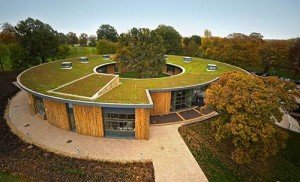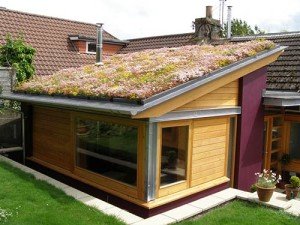Green roofs or living roofs are becoming more popular. What are the advantages of green roofs? How does a green roof work? What types of green roof are there?

In Britain we are losing more of our green space and trees, which has contributed to flooding and also causes issues for wildlife. Where I live I've seen an increase in people tarmacing over their garden to create a driveway. This means rainwater can't be absorbed by plants and the earth so it ends up overloading our drains and causing flooding. The situation is also made worse by people who decide that they don't want a lawn or traditional garden, so they cover it with stones or decking. With Britain suffering some of the worst flooding in recent years and traditional drainage systems unable to cope with increasing rainwater levels. It is becoming ever more important to look at innovative ways to help the environment which is why I wanted to look at the advantages of green roofs as they offer some great environmental benefits.
What are green roofs?
A green roof is when a roof of a building is covered or partly covered with vegetation and plants such as mosses, sedum, wildflowers and shrubs. Green roofing has become more popular in cities and densely populated areas where there is a lack of green spaces. Some of the many advantages of green roofs are that they can be used to help reduce flooding caused by heavy rainfall in places such as New York and in Mexico it's used to reduce pollution.
How does a green roof work?
Green roofs can be installed on most buildings with a suitable flat roof which can take the weight of a garden. They can work on a sloping roof but it's better if the slope is less than 30 degrees.
Green roofs consist of three layers:
- a waterproofing membrane
- a layer of soil
- vegetation on top
What is an extensive roof garden?
Extensive roofs have a thinner layer of soil and are suitable for shallow rooted plants such as mosses and sedum that are fairly easy to maintain.
What is an intensive roof garden?
Intensive roofs have deeper soil and so can cope with hardier plants and sometimes even trees with stronger roots.

Advantages of green roofs
Green roofs can turn unused space into a visually stunning and environmentally-friendly landscape. Here are just some of the ways in which a green roof can benefit you and the environment:
Save energy and money
Green roofs provide an insulating effect by improving the roof's thermal performance which means they can reduce energy use in summer and winter.
Creation of wildlife habitat
As more of our wildlife habitat is destroyed and the population grows, a green roof can provide a rare undisturbed habitat for wildlife such as insects and birds. Living roofs can be designed to mimic the local environment which helps key, often protected, species in line with Biodiversity Action Plans (BAPs), ecologists’ specifications and local initiatives. Sky Garden, a supplier and installer of green roofs, designed and installed green roofs in London specifically for stag beetles (Lucanus cervus) in line with the 2012 London BAP.
Reduction in flooding
You only have to look back to the last few months to see how flooding is getting worse in the UK. Roofs made out of materials such as slate, concrete or waterproof membranes direct rainwater rapidly into drain. This surge in water flow is too much for our Victorian sewer systems which means that Combined Sewerage Overflows (CSOs) are used when sewers become overloaded and in danger of flooding.
In London, there are 57 Combined Sewerage Overflows which discharge around 39 million tonnes of untreated sewage annually into the Thames.
Compared with traditional roofs, green roofs reduce the volume of rainwater run-off, and attenuate the flow helping to prevent sewerage discharges & floods. According to Sky Garden “green roofs can typically retain 80% of rainfall in the summer months“.
Noise insulation
Living roofs can reduce noise pollution as sound waves are absorbed, reflected or deflected. The growing medium tends to block lower sound frequencies whilst the plants block higher frequencies. The amount of sound insulation varies according to the system used and the substrate depth. Sky Garden say that a standard sedum blanket green roof can reduce sound by 8dB compared with a conventional roof system. If you live in an area of high noise pollution, such as near an airport, a green roof could improve your quality of life.
Additional green space
Rooftop gardens can also create a green oasis for people whose home doesn't have a traditional outdoor space or garden such as those living in flats and apartments in cities.
Pollution filter
Another one of the advantages of green roofs is they filter any rain water run-off thereby capturing carbon dioxide and other pollutants improving the air and water quality.
Types of green roofs
There are various different types of green or living roofs depending on your needs and aims. Sky Garden's vegetation is grown by their experts at their local Gloucestershire nursery and they offer the following green roof systems:
Sedum Systems
The traditional green roof system and is the one I've mostly seen around the UK. The sedum comes in either a
- sedum blanket which is a pre-grown mat of mature sedum plants
- sedum plug plant system is individual sedum plug plants planted across the roof
Wildflower Systems
A wildlflower green roof sounds incredible and consists of a 38 species of wildflowers and grasses sown into a wildflower blanket which will look stunning whilst also offering habitat to pollinating insects.

Bio-diverse Systems
Sky Garden’s bio-diverse system aims to reduce the ecological impact caused by the building as much as possible. It's also known as a ‘brown roof’ system as it mimics the surrounding environment that has been replaced by the building. The substrate is contoured to allow for a variety of native species to establish and it's usually left to self-seed to create an authentic replacement for the lost habitat.
Modular Systems
Pre-formed cells ‘click’ together to create a complete green roof quickly and without fuss. Each recyclable polypropylene tray has built-in water retention plus a filtration layer, growing substrate and sedum plants.
Thank you to Sky Garden for providing photos and some of the info.
Join the discussion
Have you installed a living roof? Are you thinking of getting a green roof?
Found this website useful?
Please consider donating a few pounds to help me develop this site. Or share this post with your friends and follow me on social media. Thanks for your support!
